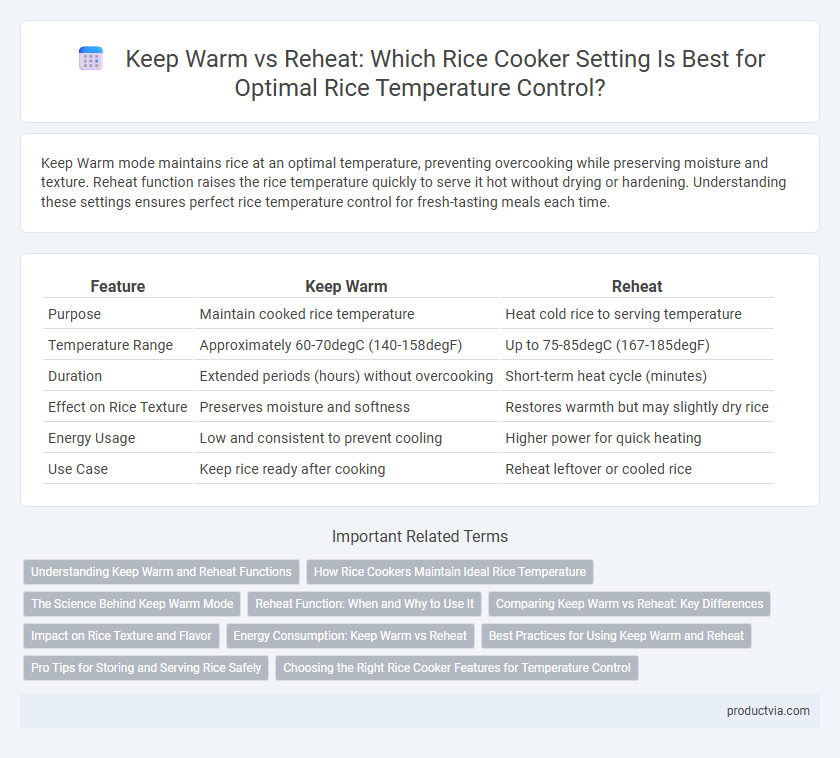Keep Warm mode maintains rice at an optimal temperature, preventing overcooking while preserving moisture and texture. Reheat function raises the rice temperature quickly to serve it hot without drying or hardening. Understanding these settings ensures perfect rice temperature control for fresh-tasting meals each time.
Table of Comparison
| Feature | Keep Warm | Reheat |
|---|---|---|
| Purpose | Maintain cooked rice temperature | Heat cold rice to serving temperature |
| Temperature Range | Approximately 60-70degC (140-158degF) | Up to 75-85degC (167-185degF) |
| Duration | Extended periods (hours) without overcooking | Short-term heat cycle (minutes) |
| Effect on Rice Texture | Preserves moisture and softness | Restores warmth but may slightly dry rice |
| Energy Usage | Low and consistent to prevent cooling | Higher power for quick heating |
| Use Case | Keep rice ready after cooking | Reheat leftover or cooled rice |
Understanding Keep Warm and Reheat Functions
The Keep Warm function in rice cookers maintains rice at a consistent temperature of around 60-70degC to prevent spoilage without overcooking, preserving texture and moisture. The Reheat function raises the temperature quickly to about 75-85degC, effectively warming cold rice for immediate consumption without drying it out. Understanding these temperature controls helps users optimize rice quality and food safety by choosing the appropriate setting based on rice consumption timing.
How Rice Cookers Maintain Ideal Rice Temperature
Rice cookers maintain ideal rice temperature by using built-in thermostats and sensors that monitor heat levels to keep the rice at a safe, warm temperature without overcooking during the Keep Warm mode. The Keep Warm function typically maintains rice at around 60-70degC, preserving texture and moisture, while the Reheat setting raises the rice temperature quickly to 75-85degC for serving, ensuring food safety and freshness. Modern rice cookers often employ fuzzy logic or microcomputer technology to adjust temperature precisely, preventing dryness or overheating.
The Science Behind Keep Warm Mode
Keep Warm mode in rice cookers maintains rice at a temperature typically between 60degC to 75degC to inhibit bacterial growth while preserving moisture and texture. This controlled heat slows starch retrogradation, preventing the rice from becoming hard or dry during extended warming periods. Unlike reheating, which rapidly raises the temperature to serve, Keep Warm provides gentle, sustained heat optimized for food safety and quality retention.
Reheat Function: When and Why to Use It
The reheat function in rice cookers actively restores rice to an optimal serving temperature by evenly warming it without overcooking or drying out the grains. Use the reheat setting when rice has cooled down after the initial cooking cycle to quickly bring it back to a fresh, ready-to-eat state while preserving texture and moisture. This function is ideal for maintaining food safety and quality during meal prep or when serving rice in multiple batches.
Comparing Keep Warm vs Reheat: Key Differences
Keep Warm mode in rice cookers maintains rice at a safe, steady temperature of around 140degF (60degC), preventing bacterial growth and preserving texture for hours without further cooking. Reheat function, by contrast, raises the temperature more rapidly, typically to around 165degF (74degC), effectively restoring warmth to cooled rice without drying it out. Understanding these key differences ensures optimal rice quality and food safety based on whether rice is freshly cooked or previously stored.
Impact on Rice Texture and Flavor
Keep Warm mode maintains rice at a stable temperature around 60-70degC, preserving moisture and texture without overcooking or drying out the grains. Reheat function rapidly raises the temperature closer to 100degC, which can alter the rice's original texture, sometimes causing dryness or uneven heating. Proper use of Keep Warm ensures consistent softness and flavor retention, while excessive reheating may degrade the rice's quality.
Energy Consumption: Keep Warm vs Reheat
Keep Warm mode in rice cookers maintains rice temperature around 60-70degC with minimal energy use, typically consuming less than 10 watts per hour. Reheat mode rapidly raises rice temperature to serving levels, requiring more power, often between 300-500 watts but for shorter cycles. Choosing Keep Warm conserves energy over extended periods, while Reheat delivers quick temperature boosts at higher, short-term energy consumption.
Best Practices for Using Keep Warm and Reheat
Keep Warm maintains rice temperature around 140degF to 165degF, preventing bacterial growth while retaining moisture and texture. Reheat cycles bring rice back up to at least 165degF quickly, ensuring safe consumption and restoring ideal serving temperature. For optimal results, use Keep Warm for short-term holding up to 12 hours and engage Reheat only when rice has cooled below safe temperatures.
Pro Tips for Storing and Serving Rice Safely
Keep Warm settings maintain rice at a safe temperature around 140degF (60degC) to inhibit bacterial growth, ensuring freshness without overcooking. Reheating rice should reach at least 165degF (74degC) to eliminate potential pathogens, making it safer for consumption. For optimal storage, cool rice quickly and refrigerate within two hours to prevent foodborne illnesses.
Choosing the Right Rice Cooker Features for Temperature Control
Selecting a rice cooker with precise Keep Warm and Reheat functions ensures optimal rice temperature control by maintaining freshness without overcooking or drying out the grains. Quality models use advanced sensors to regulate heat, keeping rice at safe serving temperatures around 60-70degC while preventing nutrient loss and texture change. Choosing a cooker with customizable temperature settings and automatic shift from cooking to Keep Warm mode enhances both convenience and rice quality.
Keep Warm vs Reheat for rice temperature control Infographic

 productvia.com
productvia.com